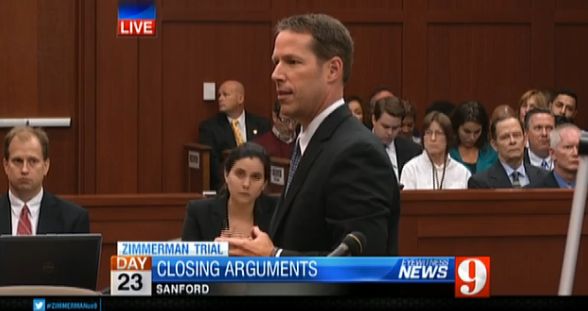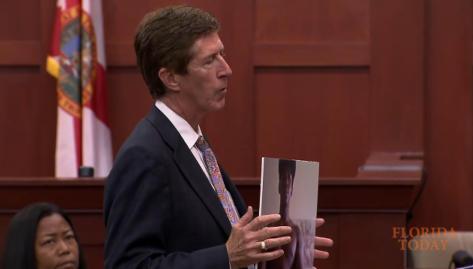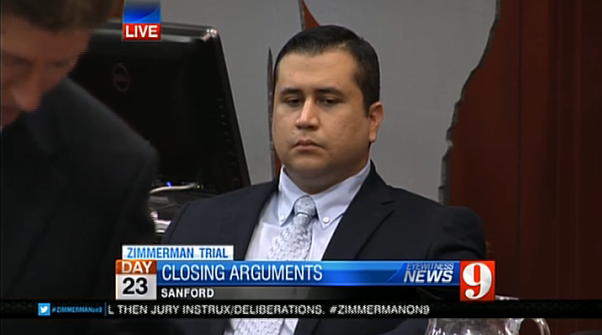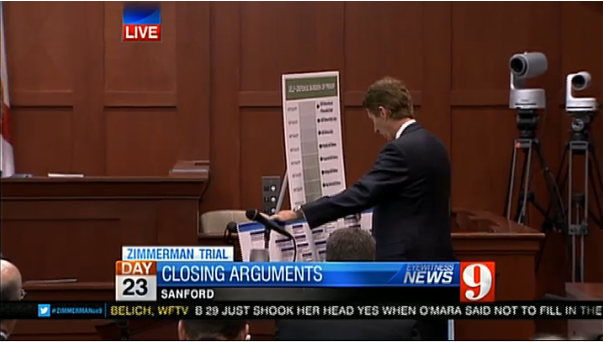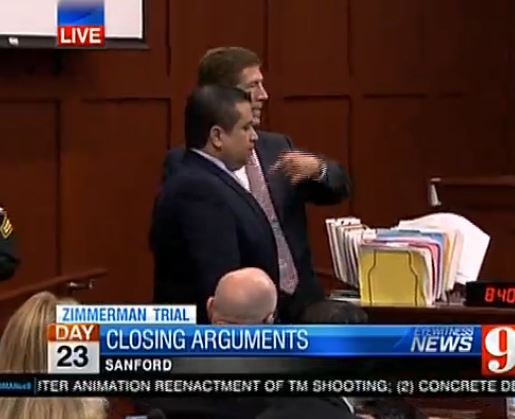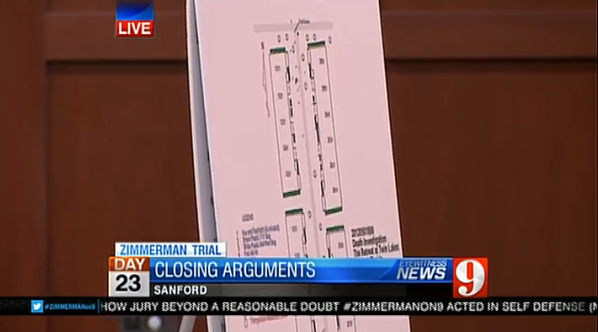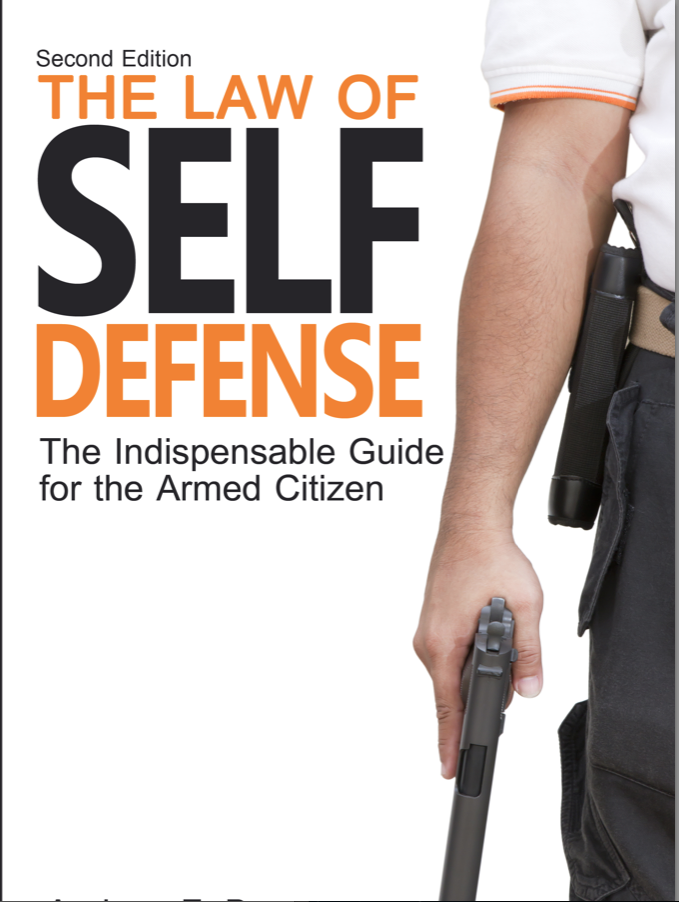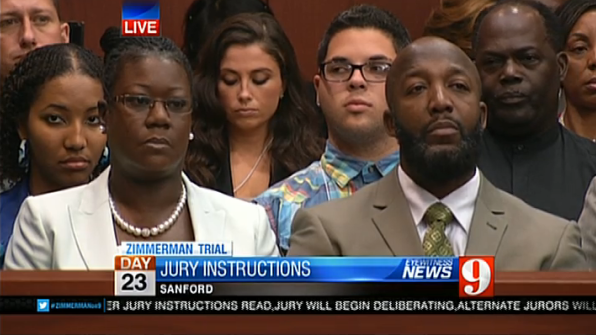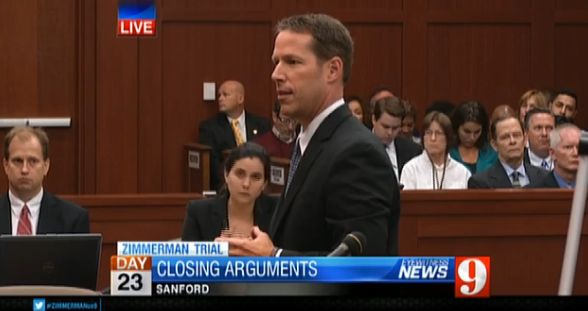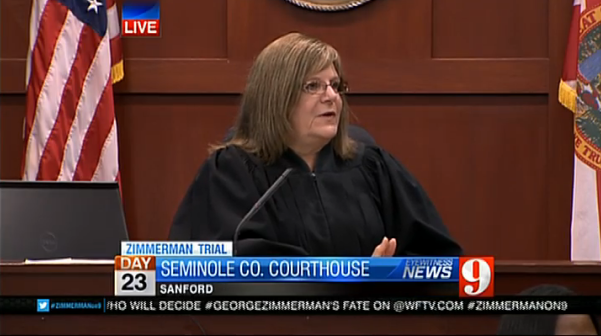(Note: the first couple of paragraphs reflect today’s earlier, short post. To start at the newest updates, skip to the first heading, “Mark O’Mara Delivers Compelling Narrative of Innocence Based on Evidence & Law.” The remainder of the post also contains embedded and linked video of both the defense closing and the State rebuttal.)
This morning saw the defense give its closing statement in Florida v. Zimmerman, the last opportunity for them to deliver their compelling narrative of innocence to the jury. And boy, did Mark O’Mara deliver. In a closing rich with evidence, facts, and the law, O’Mara focused the jury on their legal obligation to deliver a verdict consistent with the State’s burden to prove Zimmerman’s guilt beyond a reasonable doubt.
O’Mara stepped them through every significant piece of evidence, and every single witness that had appeared in court. He reminded them of their duty to come to a verdict using only the evidence actually presented at trial, and that any “filling in the gaps” must be seen as contributing towards reasonable doubt, and therefore towards a not guilty verdict. He urged them to do the opposite of what the State had suggested in Bernie de la Rionda’s (BDLR) fact-free closing, when the State seemed to suggest that the jury not be overly concerned with the evidence but rather apply their “common sense.”
O’Mara’s last few sentences were particularly powerful. He urged the jury, when they went into deliberations, to consider self-defense first. Because unless the State has disproved self-defense beyond a reasonable doubt, they must find George Zimmerman not guilty.
It was, in short, a masterful closing of the highest order, appealing to the civilized qualities of the jurors and their legal and moral charge.
In response, Mr. Guy delivered the State’s rebuttal closing in a manner that was even more fact-free than had been BLDR’s–something I hadn’t imagined possible. He started an immediate emotive appeal to the “human heart”, and never looked back. He referred to Martin as a “child” at least a half-dozen times, and Zimmerman as a “grown man”. What he did not do, what he could not do, was argue facts in evidence to exclude any reasonable hypothesis consistent with innocence. This was yet another childish and histrionic “performance” by the State in a prosecution that had long since become their Gallipoli.
Mark O’Mara Delivers Compelling Narrative of Innocence Based on Evidence & Law
Mark O’Mara began his closing argument today with the directness and command that have been his a hallmark throughout this trial. After thanking the jurors for their patience, he immediately focused their attention on his fears. He was concerned, he said, that the the jury might attempt to apply their normal decision-making process, the one that works perfectly well in day-to-day life, in their deliberations of the guilt, or non-guilt, of George Zimmerman.
Necessity for Jurors to be Deliberative and Focused on the Facts in Evidence
In normal life, he noted, we make decisions all the time on vague and incomplete facts–it’s just not worth the time and effort to nail everything down to the last degree of certainty. We move through life with a broad range of assumptions–we assume that car isn’t going to suddenly swerve into our lane, for example. We use these assumptions to fill in the holes left by the fact we don’t have. It’s perfectly normal and natural way to deal with a complicated world.
It is also, he said, completely inappropriate for determining guilt or the lack thereof. He feared, he said, that if the jury applied the vague, assumption-filled decision-making process of day-to-day life to this case, the result would be an injustice to Mr. Zimmerman. Instead, the jury is charged with applying a type of decision making with standards of certainty and proof substantially higher than that used in daily life.
Facts in Evidence, Not Emotion, Lead to a Just Verdict
This higher standard is a direct consequence of the fact that the American legal system places upon the State the burden of proving the guilt of the defendant guilty beyond a reasonable doubt. Not just in a general sense, but on each and every specific element of the crime charged.
The State, he noted, had seemed to suggest in the closing argument of Bernie de la Rionda (BDLR) that a looser standard than what was legally required, a standard merely of “common sense”. While it was, indeed, important to use common sense in deliberations, however, the standard of guilt–beyond a reasonable doubt–meant a finding much more substantive and certain than the phrase “common sense” might suggest.
Assumptions and Speculation Lead to Injustice
In this courtroom, and in the jury’s deliberations, they were not allowed to fill in any gaps with assumptions of what might have been. If there was no evidence on an issue, the issue was as a matter of law unproven, or at least uncertain–and any uncertainty had to be resolved in favor of the defendant, as it contributed to reasonable doubt.
As an aside, at this point in his closing O’Mara delivered what has become one of his trademark moves, a subtle, swift jab to the larynx of the State’s theory of the case. What do you know about Trayvon Martin? Not much. But if a decision was made by the State to not present some particular evidence about Trayvon Martin, you mustn’t’ consider the matter. O’Mara might as well have told the jury to not think about pink elephants-thinking about what the State might have held back about Trayvon Martin could only have been at the forefront of their minds after O’Mara’s low-key remark.
His concern, he said, was that the way decisions must be made in deliberations was sufficiently different from how we normally make them that it requires particular care on the part of the jury to not default to them more normal, comfortable approach.
Zimmerman Has No Duty To Testify, Although In A Sense He Had
O’Mara noted that George Zimmerman was not required to prove anything, was not even required to testimony–although, he noted, you have heard him testify, repeatedly, in the many audio and video recordings introduced into evidence by the State. This was another nice move by O’Mara, as it implicitly gathered to Zimmerman the benefit of a defendant who “has testified,” without ever placing his client in the jeopardy of a cross-examination.
The Jurors Are “Living the Constitution”
The burden, O’Mara emphasized again, is on the State to prove Zimmerman’s guilt beyond a reasonable doubt. Why have such a high burden on the State, why is it important? In answer O’Mara began quoting from our Founding Fathers, including the great American lawyer John Adams, as well as Thomas Jefferson. “You,” he told the jury, “are living the Constitution in your deliberations.”
State Raises Reasonable Doubt, While Defense Drives to Certainty
O’Mara mentioned that he had come to refer to Florida v. Zimmerman as the bizarro case, because it seemed to be turned all around. Normally, it was the State prosecutors who spoke in terms of definite findings of fact, of “did” and “had” and “must,” and it was the defense that spoke in terms of uncertainty, of “what if,” and “could have,” and “might have been.” It is the State that has the charge to provide near-certainty, the defense lawyers who are charged to create a doubt. Yet “how many what-ifs have you heard from the State in this case?” he asked pointedly. (Certainly, this writer lost count weeks ago.)
He knew how prosecutors ought to approach the pursuit of a conviction, O’Mara said, because he used to be a prosecutor before, and used to use those definite terms when asking a jury to return a verdict of guilty. “Those,” he said, “are the words of good prosecutors.” ( There was more than a little emphasis on the “good”.)
The Reasonable Doubt Continuum, and the Threshold for Guilt
At this point O’Mara pulled out two charts, one illustrating the continuum of “doubt” from considerable to beyond a reasonable with respect to the criminal charge, and the other taking a similar approach with regard to the defense of self-defense. In both cases, he pointed out, a guilty verdict could be returned only if the jury was convinced the State had successfully secured a position at the highest levels of certainty, beyond a reasonable doubt. The vast majority of those continuums required, mandated, that the jury return a verdict of not guilty.
State Must Prove Beyond Reasonable Doubt That No Self-Defense
In the context of self-defense he noted that the State must prove, beyond a reasonable doubt, that George Zimmerman did NOT act in self-defense. If the jury concluded that self-defense was likely in this case, their verdict must be not guilty. If they decided self defense was unlikely, but might have been? Not guilty. If they found self-defense was less than likely? Not guilty. Even if they decided that self-defense was highly unlikely in this case, but they retained a reasonable doubt–not guilty.
In terms of the criminal charge the State has to prove guilt to the exclusion of any reasonable doubt whatever. Only then may the jury return a verdict of guilty. Only then.
Let’s Talk About the Evidence
“So now,” O’Mara segued, “let’s talk about the evidence.” That simple sentence could only reinforce how little BDLR had touched upon the evidence in his lengthy, meandering closing the day before.
Zimmerman, the “Wannabe” Cop
He started with the contention by the State that George Zimmerman was a “wannabe cop”, with every evil connotation they could associate with the phrase. Indeed, O’Mara acknowledged, Zimmerman was a “wannabe cop.” And a wannabe prosecutor, lawyer, and helpful neighbor. He reminded the jurors of all the law enforcement officers who had testified during the trial, called by both the State and the defense (sometimes the same individual by both). They were not merely wannabe cops, they had actually become cops–and all, without exception, had found a life calling in honorable service to protect their communities. Just as George, in his own small way, sought to serve and protect.
What Was Learned When State Called Professors To Testify?
The State had an obligation to prove to you that George had engaged in inappropriate conduct, if they wished you to use that conduct in support of guilt. So, who did they bring? Two professors. The first said that George Zimmerman was a nice guy, who wanted to be a lawyer and a State prosecutor. The other professor, O’Mara reminded them, had provided a fairly comprehensive lecture on the law of self-defense. (It’s likely the jurors also recalled Captain Carter greeting George Zimmerman warmly by name as he entered the courtroom.)
Why Had the State Withheld Evidence from the Jury?
O’Mara then reminded the jurors that the State had also provided them with a half-dozen additional audio recordings of Zimmerman phoning the police to report other suspicious activities. Actually, he corrected himself, the State had only provided five of those tapes–it was the defense that made sure the sixth tape was included. Why, he pondered, would the State have left out that sixth tape? He encouraged the jury to listen to that sixth tape themselves, and see if they could discern a motivation by the State that was consistent with the State’s claim that they were simply seeking justice.
And when you listen to the tapes, O’Mara suggested, listen to Zimmerman’s voice. Is he shouting at the police to get over here and get these guys, get these young black males? No. The only shouting, in fact, has been done by the State. Don’t, he urged the jury, allow the State to put their own words, their own ton, into the mouth of George Zimmerman.
The Crime Wave of Twin Lakes
O’Mara talked about the wave of crime through Twin Lakes, and told the juror they would find a pile of police reports about these crimes in the evidence they would receive. Look through it, he urged them. Was George Zimmerman frustrated? Of course, would it not be reasonable to be frustrated under the circumstances?
Where Was the Witness to Zimmerman’s Seething Hatred? Anyone?
At its opening statement the State had suggested that Zimmerman was “playing cop,” and “patrolling” the neighborhood, overzealously looking for trouble. In fact, Zimmerman took the same trip to Target every Sunday evening, to gather the foodstuffs he used to make his lunches for the week. Indeed, there was not a single witness who testified that Zimmerman patrolled the neighborhood. Why not? The State had not produced a single witness who could personally testify as to his allegedly “angry, seething” tone of voice? Why not?
State Asking, Demanding, that Jury Adopt Its Assumptions
Instead, the State wants you to assume that because they say it, it must be true. And you would have to assume it, because there’s no actual evidence. The State wants to make Zimmerman out to be a hateful man looking for people to harass. Yet they have no evidence, none. Well, if Mr, Guy thinks, O’Mara challenged, he can show me wrong in his rebuttal.
Recall the home invasion victim that did testify, Bartolo. If Zimmerman had come to her and ranted like an angry maniac about criminals, somehow swore vengeance, surely the State would have elicited such testimony. Why didn’t they? She did testify about what Zimmerman did, however. Zimmerman gave her a lock to secure her door. He gave her his phone number in case she needed any help. He offered to have her spend time with his wife Shellie, to comfort her.
The night of the event, did this angry, seething vengeful wannabe cop run out of his car with his gun in his hand to track Martin down? No, he did just what he was told to do–identify the direction in which Martin had gone.
The Only People In Case Who Ever Shouted Expletives Were State Prosecutors
What about the language, the expletives uttered by Zimmerman, that the State used as the cornerstone for its characterization of Zimmerman as consumed by hate, spite, and ill-will, by a depraved mind? You’ve heard the words enough, O’Mara noted, unwilling to repeat them again. Certainly he was not going to shout them out. Mr. Guy shouted them out. Mr. de la Rionda shouted them out. But George Zimmerman never shouted them out. Not that night, not ever.
Where’s the Hatred, Ill-Will, Spite, Required for a Depraved Mind?
O’Mara then presented a ten-foot long graphic representing the timeline of Zimmerman’s non-emergency call to the police. It was somewhat difficult to follow some of his discussion here, as the chart was not visible to me. But the real key points didn’t really require sight of the chart. O’Mara noted that the State wants to make a big deal out of the dispatcher saying, “We don’t need you to do that,” but also wanted you to ignore, “let me know if he does anything else.” At the point where Zimmerman says, please get an officer over here,” O’Mara pauses and asks, “Is that evidence of hate, ill-will, spite?”
At the moment when Zimmerman mutters, “These assholes, they always get away,” O’Mara paused again and asked, “Is that hate, ill-will, spite? Did George Zimmerman say those words as Mr. Guy did, as Mr. de la Rionda did?
Then Trayvon runs, and the dispatcher asks, “What’s he doing, which way is he going?” Is that, O’Mara wonders, the moment that the wannabe cop was supposed to have cracked, the straw that broke the camels back? Is there some crescendo of hatred evident in the tape?
When the dispatcher asks, “Are you following,” what does George Zimmerman say in response that shows his hatred, his angry desire to track down and kill Trayvon Martin? He says yes. When the dispatcher tells him, “We don’t need you to do that?” is that when George Zimmerman snaps? No, he simply says, “OK.”
Where is the Evidence that Zimmerman Pursued Martin?
Indeed, O’Mara asks, is there any evidence whatever to support the State’s conjecture that George Zimmerman ran after Trayvon Martin after he told the dispatcher, “OK”? O’Mara issued another challenge to the State–let them show you, he told the jury, with evidence that George Zimmerman so much as walked after Trayvon Martin after he said “OK.” Because the evidence is simply not there.
The State wants to suggest that the encounter occurred some distance down the dog walk, as if Zimmerman had pursued Martin toward’s his destination. But based on what evidence. We know that the little flashlight with the key ring was found at the T, right where Zimmerman says Martin confronted him. Jenna Lauer’s testimony was also consistent with the confrontation starting at the T, as was Sudyka’s testimony, and that of Manalo–all State witnesses.
The Animated Video
O’Mara then spun up his animated video, which simply portrayed the actions as purported by the defense. The video itself didn’t strike me as particularly compelling, but the fact that it showed the defense’s recounting of events was completely consistent with the evidence of the case, and therefore both were consistent with a narrative of innocence, was compelling.
What Was Martin Doing During the Four Minutes He Could Have Gone Home?
O’Mara then turned the tables on the State. They’ve raised questions about these mysterious two minutes, he noted, and about what George Zimmerman was doing during that time. But what about Trayvon Martin? What was he doing? He started running at 7:11:47, as noted in the non-emergency call of Zimmerman. The call of Jenna Lauer that captured the sound of the fighting, and which she made within seconds of hearing the first verbal exchange of the confrontation between Martin and Zimmerman, was at 7:16:11. So there are almost four minutes of time from when Trayvon Martin ran until their actual confrontation.
Having the Jury Sit, in Silence, for Four Minutes
At this point O’Mara, who had already been speaking for more than an hour, announced he would take a short break. Before they recessed, however, he wanted to ask the jury to simply stay where they were, sit in place, not talk, until he told them otherwise. Then, in a wonderful piece of courtroom theater, he simply stayed silent for four minutes. Finally, he said, “that’s how long Trayvon Martin had to run, if he wanted to run, four minutes. To reach safety, he had to run perhaps slightly further than a man could throw a football. Yet in the same time that a man can run a mile, Trayvon Martin was unable to move even a couple of hundred feet. Or unwilling to.
And, by the way, O’Mara noted, did the State make any effort to explain to you what Trayvon Martin was doing for those four minutes? Why not? Does that raise doubt in your mind about their theory of the case?
After a brief recess, O’Mara was back on the four minutes. We know, he said, that Trayvon Martin had ample opportunity to secure safety, to get home. We know that. But he didn’t.
Somebody WAS Filled With Ill-will, Spite, Hatred–Just Not Zimmerman
It’s true, he said, that someone was angry that night, filled with ill-will, spite, and hatred. The person who felt those emotions was the guy who could have gone home, but chose not to, who chose instead to wait. The State, O’Mara said in his first show of outrage, dares to tell you that Trayvon Martin made no decisions that night? Well, they say they want you to use your common sense, let’s do so. Trayvon Martin was doing something, for certain.
In an interesting twist, O’Mara then highlighted how weak the State’s theory of the case was in the face of countervailing evidence. Let’s toss away, he suggested all of George Zimmerman’s statements consistent with self-defense. The State says they are self-serving lies. Ok, let’s say he never made them. What does that leave us with?
It leaves us, O’Mara said, with this–and he held up the worst of the bloody photos of Zimmerman’s face, his nose crushed sideways and blood running down his lip, taken by Officer Tim Smith while Zimmerman sat in his patrol car.
You, he told the jury, should tell the State with your verdict, don’t ever come back to us with a case like this. Because you can go into deliberations right now, place the burden of proof of self defense on the defense beyond a reasonable doubt, and you would still have to conclude not guilty. But of course, that’s not the legal standard, the legal standard is the State has to disprove self-defense beyond a reasonable doubt. It merely illustrates how far they are from being able to do so.
Of course, O’Mara said, I’m not going to suggest that Trayvon Martin did anything bad . . . (and don’t think about pink elephants).
Zimmerman, Wannabe Cop?
O’Mara then moved back to the State’s wannabe cop theory. This wanna be cop, he noted, was offered a chance to be as close to a police officer as his life was likely to take him. A patrol car, with flashing yellow lights. A uniform of sorts. A charge to genuinely patrol the neighborhood. And what did this desperate wannabe cop say to this offer? No thanks. Hatred, spite, ill-will?
Evidence Favorable to the State, Gutted
O’Mara then spoke to the few witnesses who presented some appearance of favorable evidence for the State. Frankly, he needn’t have bothered, because neither Bernie de la Rionda nor Mr. Guy ever referenced any of these witnesses (but, of course, he could not know yet what Guy might say in his rebuttal). Bahadoor’s credibility was quickly exposed for the shell it was, Sudkya he treated kindly as simply traumatized by the event, Manalo as having been misled by the widespread distribution of the 12-year-old Trayvon photos.
Then O’Mara got to Rachel Jeantel, and sighed. Clearly, he said, she didn’t want to be involved in the case. Did he care that she’d lied about her age, or her name, or about being in the hospital? No. But clearly her crystalline memories at her deposition by BDLR, Crump, et al. of a phone conversation that took place weeks earlier was simply not credible. In any case, the setting in which the deposition was taken–in Trayvon Martin’s living room, seated next to the crying mother, surrounded by Trayvon’s family and family lawyers, and speaking to a State prosecutor whose job is to send people to jail–it’s hard to imagine a more coercive environment or how that would have affected her recall. Remember, “oh, you want that, too?”
Indeed, the more coercive the environment and the more it might have influenced her testimony, the more that testimony must be discounted, and the greater the uncertainty and reasonable doubt.
Stepping Through Every Witness, State and Defense, In Search of Guilt–Nothing
At that point O’Mara continued to transition from one witness to the next, both State and defense, providing a brief recollection of their testimony and its implications for a verdict. Of the few whose testimony seemed to favor the State, he had already addressed Bahadoor, Sudyka, and Manalo. Drs. Rao and Bao pretty much discredited themselves. Sabryna Fulton, well, of course she wanted to believe it was Trayvon’s voice. The half-brother Jaharvis didn’t really know. Tracey Martin had first concluded that the screams were not those of his son.
All of the other witnesses, whether called by the State or defense, provided testimony that was entirely consistent with Zimmerman’s narrative of self-defense and innocence. Many of them compelling so, especially the defense witnesses Jorge Meza, Dr. Di Maio, Adam Pollack, Mark Osterman, and Dennis Root.
“He Had No Other Choice”–Uncontested Testimony of Dennis Root
Speaking of Dennis Root, the expert in the defensive use of force, he was asked by BDLR, “George Zimmerman had other choices that night other than to shoot Trayvon Martin, didn’t he?” And Root answered, “No, he did not.” So, sure, Root was a defense witness, maybe you want to discount his testimony because of that. But why didn’t the State offer its own defensive use of force expert, to describe these purported alternatives that Zimmerman had at his disposal? Did they provide so much as one shred of evidence for these claimed alternatives?
Recall the grass stains on Martin’s knees, and the wetness on the back of Zimmerman’s jacket and pants—totally consistent with Zimmerman’s claim of self-defense, of being knocked to the ground, mounted, and beat upon, head smashed into sidewalk.
Weighing the Testimony–Credible, nor Not?
O’Mara also spoke to how the jurors were to evaluate and weight the testimony of different witnesses. Were they all honest or straightforward? Take Mora, the Sanford PD coordinator for Neighborhood Watch programs and her forthright responses to questions, all entirely consistent with her earlier depositions. Compare her to Bahador, whose key piece of testimony–that she had heard movement from left to right, suggestive of a pursuit–was uttered for the first time when she appeared in court, after having consulted with Prosecutor de la Rionda the night before.
Setting Sympathy for Martin Family Aside in Seeking A Just Verdict
He reminded the jury that he had asked them at voir dire if they would be able to return a verdict of not guilty with the Martin family in the courtroom, if the State had failed to prove guilt beyond a reasonable doubt, and they said they could. It was their duty, he said, to base their deliberations on the facts in evidence, and their common sense, but not assumptions, not speculation, as the State had suggested. You must, he said, leave your natural sympathy for the Martin family’s loss at the door, outside of your judgment of guilty or not guilty.
The Law of Self-Defense
Next O’Mara transitioned into the law of self-defense. Zimmerman did not need to think he was going to die, he noted, in order to be justified in using deadly force in self-defense. He merely needed to have believed he was going to suffer serious bodily injury. The threat didn’t even need to be actual or real, so long as a reasonable person would have perceived it to be real.
The jury would be read a number of laws by the judge, he told them, but there were also laws they would not be read because they did not exist. There was no law against merely following somebody, for example. Following somebody suspicious and reporting them to police is not a crime, not an act of wrongdoing.
Why Had the State Withheld, Distorted Evidence?
He then returned to the theme of the many things the State had, for whatever reason, not chosen to present to the jury.
Why had it been the defense who showed the jury that Tracey Martin had first denied that the screaming was the voice of his son? If the State was seeking justice, the truth, why hadn’t they presented that evidence to the jury?
Why didn’t the State tell you about the many robberies, the veritable crime wave, overrunning Twin Lakes, almost entirely the work of young black men? Why had it been the chore of the defense to ensure those records were in the evidence for the jury’s consideration, if the State was seeking justice, the truth? Where was the State’s expert on defensive force? The State’s expert on gunshot wounds? Remember how in their opening the State claimed that a key indicator of guilt that Zimmerman had pressed his gun into Trayvon Martin? Where was their expert to counter Dr. Di Maio’s conclusion that this never occured?
Why, O’Mara asked, had Mr. Guy and Mr. de la Rionda shouted those expletives at you, over and over. You heard the tapes, he reminded them, and Zimmerman never shouted those words. Were they shouting them to help you find the truth? Do we really need demonstrations of anger from the prosecutors towards the jury?
Where Was Even One Piece of Evidence That Zimmerman Attacked Martin?
Clearly there was a confrontation between the two men, O’Mara noted, given Zimmerman’s plain injuries. But where were Martin’s injuries, if it had been Zimmerman who attacked him? There were none, except some minor cuts on his hands consistent with having punched someone.
Indeed, he asked, was there even one piece of evidence that Zimmerman attacked Trayvon Martin. That Zimmerman did anything to justify Trayvon Martin’s blows against him? Mr. Guy, he noted, could point any such evidence out when he rebutted. Even the testimony of Rachel Jeantel, if believed, showed only that ZImmerman may have verbally challenged Martin. But what’s the appropriate response to such a verbal challenge. Mr. Root, the defensive force expert, told us–a counter verbal challenge. Not striking a blow, breaking someone’s nose, driving them to the ground, mounting them, and continuing to beat them while they screamed for help and neighbors threatened to call 911. Indeed, if Martin had been shot through the hip and survived, is there any doubt that the State prosecutors would have charged and tried him for aggravated assault?
Martin Armed Himself with His Fists and the Sidewalk
The State made much of the fact that Zimmerman was armed with a gun, and Martin merely with Skittles, O’Mara said. He then lugged out into the court room a large piece of sidewalk. That, he said, was not an unarmed teenager, with nothing but Skittles trying to get home. Martin had armed himself with dangerous items, with his fists, and with concrete. Further, the claim by the State that a concrete sidewalk could not be a weapon, could not cause great bodily harm, was disgusting.
As he began to conclude his remarks, O’Mara said that he believed that the defense had actually proven Zimmerman innocent beyond a reasonable doubt. Not that this was the burden, of course. The burden was on the State to prove Zimmerman guilty beyond a reasonable doubt. But that’s how lopsided the evidence was.
Consider Self-Defense First–If That, We Can All Go Home
In a few minutes, he noted, Mr. Guy was going to stand up and call my client a liar, and a murderer. Let’s skip the details of the criminal charges for a moment. Let’s look only at self-defense. Do you think that Zimmerman may have acted in lawful self-defense. Just may have? If so, you can stop right there. Because if you have a reasonable doubt that self-defense has been disproved, you have to find George Zimmerman not guilty. Because unless the State has disproved self-defense beyond a reasonable doubt, self-defense stands, and if it stands it is an absolute defense to any use-of-force criminal charge–to murder, to manslaughter, to aggravated battery, everything.
If you conclude that the State has not disproved self-defense beyond a reasonable doubt, then you need go no further–your only choice is not guilty. And if you look at this evidence, these photos of these injuries, you have to have at least a reasonable doubt that George Zimmerman acted in self-defense.
It doesn’t mean he acted perfectly in every way. Your job is not to find the defendant “innocent”. Your job is merely to determine whether the State has me their burden to prove him guilty beyond a reasonable doubt. If they have not, the verdict must be not guilty.
And then O’Mara closed with perhaps the strongest line of an excellent close: “Go back in that room, he urged, and talk first about self-defense. Because if it’s self-defense, we’re done here.” And, he didn’t need to add, you all get to end your sequester and go home.
With that, the defense was done.
Defense Counsel Mark O’Mara, Closing Argument, Part 2
Defense Counsel Mark O’Mara, Closing Argument, Part 3
Defense Counsel Mark O’Mara, Closing Argument, Part 4
Defense Counsel Mark O’Mara, Closing Argument, Part 5
Defense Counsel Mark O’Mara, Closing Argument, Part 6
Defense Counsel Mark O’Mara, Closing Argument, Part 7
Defense Counsel Mark O’Mara, Closing Argument, Part 8
Defense Counsel Mark O’Mara, Closing Argument, Part 9
Defense Counsel Mark O’Mara, Closing Argument, Part 10
Defense Counsel Mark O’Mara, Closing Argument, Part 11
State Prosecutor John Guy Offers Rebuttal
Next up for the State’s rebuttal, was Mr. Guy. From the first words out of his mouth it was clear that his presentation was to be even more fact-free than that of Mr. de la Rionda had been.
“The human heart,” he stated, “guides us in big things and little things. Let us look into the heart of this child.”
Referring to the towering, 17-year-old high school athlete Trayvon Martin as a “child” and the clinically obese 28-year-old George Zimmerman as a “grown man” was to be a recurring theme throughout Guy’s remarks.
He emphasized to the jury that Rachel Jeantel–the State’s key witness–was a “human being,” as if the issue were in doubt.
He seemed desperate to return to the State’s long standing practice of shouting “a-holes” and “f’ing punks” at the top of their lungs, but this utility of this technique had been destroyed by O’Mara’s mockery of the practice.
Guy spoke in histrionic scary/creepy voice reminiscent of some kind of serial-killer preacher from a low-budget horror movie, in an apparent effort to add weight to statements completely unmoored from any facts or evidence.
“The defendant LIED, about stuff that REALLY MATTERED,” he said, although he neglected to specify the lies or why they really mattered. “The defendant told SO MANY lies, that’s why we’re here.” But again, he declined to state what these lies were.
“Where was the defendant for those critical two minutes,” he asked, peppering the jury with questions as if that would advance the State’s theory of the case beyond a reasonable doubt.
“I don’t have any charts or timelines,” he said, referencing O’Mara’s demonstrative tools, “I’m asking you to use your heart.” I only wish I made up that last part.
“That child”–there it is again–“had EVERY RIGHT to be at 7-11, to walk home.” As if anyone had contested these matters. “To be afraid of being followed, after all isn’t that every child’s greatest fear, being followed home by a stranger.” It was as if he believed the only photo the jury had ever seen of Trayvon Martin was that of the smiling 12-year-old, and not the 7-11 photo of the 17-year-old Trayvon Martin towering over the 5′ 10″ clerk.
He mocked the claims that Zimmerman had been able to draw his gun while Trayvon Martin was mounted atop him, and urged the jurors to learn this for themselves by mounting each other in their deliberations. (Seriously.)
Guy then began a series of speaking points, every one of which was a question, “If this . . . ,” and “If that . . . ,” in a manner perfectly appropriate for a defense counsel seeking to raise a reasonable doubt, but bordering on the mad for a prosecutor seeking to advance his theory of the case beyond a reasonable doubt.
At some points he seemed to spin off into the simply nonsensical, as when he announced “This is not a case about self-defense, it’s a case about self-denial.” What?
He then jumped on the “Zimmerman lied,” train. “It wasn’t 10 seconds from the time ZImmerman got off the phone with the dispatcher until Trayvon confronted him, it was two minutes.” Yet . . . now the State conceded that it was Martin who confronted Zimmerman?
Zimmerman could not possible have had his head smashed against a sidewalk as many times as he claimed, or he’d be dead. So how many times would be an acceptable number? 10, 5, even once?
Then things got very strange when Guy asked, “Didn’t Trayvon Martin have the right to self-defense, too?” So, apparently the complete absence of injuries of Trayvon Martin (other than the gunshot that ended the beating) allowed for him to act in self-defense, but George Zimmerman’s real and bloody injuries did not?
Guy mocked the alleged assertion by the defense that Zimmerman was a responsible gun owner by noting, “What did he do after he shot Trayvon Martin? Did he yell for an ambulance?” Having been a firearms trainer for more than two decades, that was the first time I’ve heard “calling an ambulance” as one of the characteristics of a responsible gun owner.
At one point Guy began to read an incorrect characterization of reasonable doubt to the jury, leading to O’Mara’s sole objection.
State Prosecutor John Guy, Rebuttal, Part 2
State Prosecutor John Guy, Rebuttal, Part 3
State Prosecutor John Guy, Rebuttal, Part 4
State Prosecutor John Guy, Rebuttal, Part 5
And with that, the State ended their rebuttal, and the matter returned to Judge Nelson for the charging of the jury, and to the jury for their deliberations.
 DONATE
DONATE
Donations tax deductible
to the full extent allowed by law.


